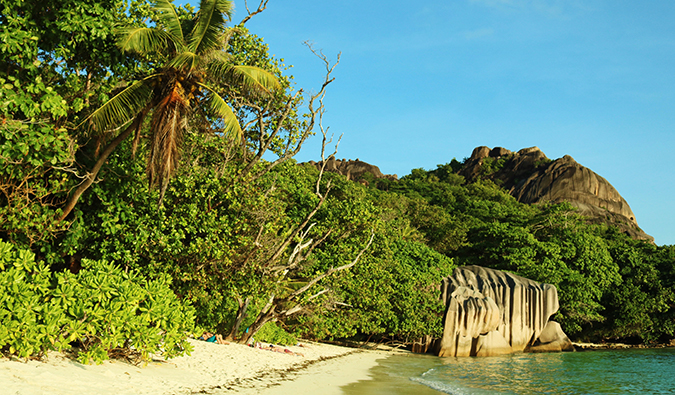
Posted: 8/1/2019 | August 1st, 2019
In this guest post, Ellie Hopgood from Endlessly Restless offers some handy tips on how you can visit the Seychelles on a budget! This is a destination I’ve always dreamed of visiting so I was excited to have her write some tips for the country! It’s always viewed as one of the most expensive in the world but, as this post shows, it’s possible to visit on a budget!
The Seychelles, an archipelago of 115 islands off the east coast of Africa, are known for being extremely beautiful — and extremely expensive. The pristine turquoise water and white-sand beaches come with a hefty price tag.
If you want to drop serious money on a holiday, the Seychelles definitely have plenty of places perfect for an eye-wateringly expensive trip, with high-end rooms at the Madame Zabre Spa Resort on Desroches Island going for almost $15,000 USD per night, as well as a plethora of rooms available in the $500-$1,000-per-night range. There are even whole islands commandeered by one resort, such as Cerf Island, which consists solely of the 24 villas that make up the aptly named Cerf Island Resort.
But even though fancy resorts like that were way out of my budget, I was determined to visit these islands — and do so frugally, with a backpacker’s budget in mind.
After spotting an obscenely cheap and convenient flight deal — and desperate to get out there and explore these beautiful islands — I booked round-trip flights from London without much research (though I don’t necessarily recommend this approach to travel planning).
I typically travel in Europe (often in Eastern Europe), so my idea of what constitutes a cheap trip might be distorted. Paying over $15 for my share of a night’s accommodation pains me. So my eyes widened when I saw the average cost in the Seychelles. But the flights were booked, so I had no choice but to figure out how to see the islands on a budget. I set to work, reading blogs and forums furiously, but there was very limited information available.
After securing some affordable accommodation, I braced myself for a painfully expensive trip — but in the end, to my surprise, it was so much easier to be budget-conscious than I imagined.
Were the Seychelles the cheapest destination? No.
But, I learned, they don’t have to be prohibitively expensive either.
So, how do you save money in the Seychelles?
Here’s how you can take an affordable trip to paradise:
1. Find cheap flights (they do exist!)
We found round-trip flights from London with British Airways for just over $600, a deal so good that it sparked the whole trip. I always use Skyscanner, as that’s where I reliably find the best flight deals. As always, you’ll typically find cheaper flights if you travel in shoulder season; are flexible with exact dates, times, and layovers; and avoid school vacation periods. Some tips on how to save on your flight:
- Look at deal websites – Deal websites like Holiday Pirates, Scott’s Cheap Flights, and The Flight Deal often have great last minute fares and package deals to the islands.
- Search the main cheap flight websites – Skyscanner and Momondo let you compare prices and see if there are any budget carriers flying the route.
- Be flexible with your dates – Airline ticket prices vary depending on the day of the week, time of year, and upcoming holidays. Moreover, it’s always cheaper to fly during the middle of the week than on a weekend, because most people travel on the weekends and airlines hike their prices then. If you zig when others zag, you are going to find better deals.
- Travel hack – This is the best way to get cheap flights..because it gives you free flights. Airline rewards programs are a great way to get free flights, free upgrades, and free companion tickets. Points = free flights. Through credit card sign up bonuses, everyday spending, contests, online promotions, bonus points, and so much more, you can easily gain hundreds of thousands of points per year without ever spending extra money! To learn how to do this, check out this post!
For more tips on how to find a cheap flight, check out this post!
2. Stick to cheap guesthouses (that serve breakfast)
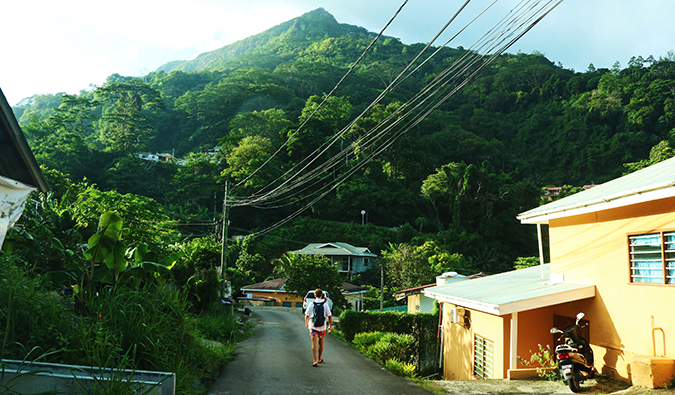
The Seychelles don’t yet have a lot of budget accommodations, but I was able to find affordable rooms using Airbnb, though similar rooms are also available through Booking.com. There are also a number of small guesthouses and hotels that offer rooms for $60–100 USD per night. While some of these places have their own websites, like our La Digue guesthouse Liane de Mai, others can only be booked through platforms like Airbnb and Booking.com, like our self-catered accommodation on Mahé via CAMEC apartments.
The best thing to do is to go onto your favorite budget accommodation site and put in the island you plan to stay on. That should show you a selection of accommodations so you can choose something in your price range.
To keep costs even lower, try to stay somewhere that offers self-catering facilities or that serves breakfast. Self-catering allows you to save by preparing your own meals, while an included breakfast takes care of a third of your meals and lets you fill up on delicious fruit, toast, yogurt, and eggs that will keep you going for hours. You can also take a few snacks from breakfast, like rolls or bananas, for later in the day when you need a boost of energy. All the places we stayed made clear in their Airbnb profile whether a kitchen was available or if breakfast was included, though you could also email and ask.
There is also a small Couchsurfing community in the Seychelles, with most of the hosts based on Mahé. Nothing is cheaper than free — so if you are fond of couch surfing and happy to stay on the main island, this might be a good option.
Check out our comprehensive resource section for more tips on finding cheap accommodation!
3. Eat take-out
Eating out in restaurants in the Seychelles is painfully pricey for fairly average food. A simple bowl of tomato pasta can easily run you $20 USD, while a three-course meal with alcohol will set you back $70–80 USD per person.
However, the Seychelles is also full of places to get take-out, small establishments, and mobile food vans all over the islands, directly alongside main roads or signposted clearly, serving up local dishes for incredibly low prices. These are where many of the locals eat dinner, along with visitors who are looking for delicious and cheap eats.
For only $3–5 USD, you can buy two main courses with a generous serving of rice and salad. These meals tend to be fresh, Seychellois dishes that change every day, typically curries made with fish, chicken, beef, or vegetables, served with rice and salad. There are also often Chinese-takeout-type dishes like fried noodles and rice.
My favorite find was Mi Mum’s on La Digue, which served the most delicious chicken “zye zye” curry with rice and salad for the unbeatable price of $4 USD.
4. Take the bus
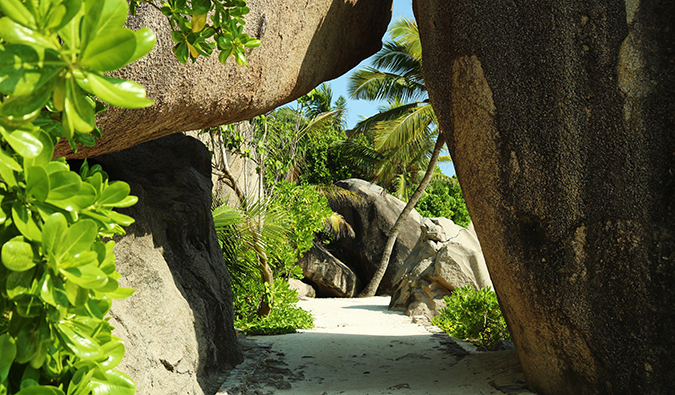
Taxis are insanely expensive — think $20 USD for a trip of only a couple of kilometers — and are not a viable option for anyone trying to travel on a budget. You can rent a car for around $40 USD per day, which may be manageable if you are traveling in a group or splitting the cost with someone, but still expensive compared to the cheapest option: the bus. (As a bonus, the bus is as much an activity as it is a convenient transport option, as the bus bounces up and down hills on a road bordering the ocean!)
On both Praslin and Mahé, you buy a flat-rate ticket as you get on and travel as far as you need to, whether that is one stop or ten. On Praslin, a bus ticket costs 7 SCR (50 US cents) while tickets are 6 SCR (45 US cents) on Mahé. The buses come infrequently, so it is worth consulting the timetable. I was given a Praslin timetable at my accommodation (though you can also find it online), and you can download Mahé’s extensive schedule here.
La Digue has very few cars and no buses, so walking and biking are the best options, which is also true for all of the smaller islands.
5. Stick to beach-hopping

While a small minority of beaches are only accessible if you are a guest of a specific resort, for the most part, the most glorious part of visiting the Seychelles (going to the beach) is completely free.
You can enjoy the pristine white sand and blue water; watch the birds, bats, and tortoises move around the island; and explore the amazing undersea wildlife straight from the beach — and it won’t cost you a dime.
My favorite free beaches are Anse Coco on La Digue, Anse Lazio on Praslin, and Beau Vallon on Mahé.
One big exception to the free beaches rule is that Anse Source d’Argent on La Digue, which is one of the world’s most beautiful beaches, charges you for entry. The cost is 100 SCR ($7 USD) for a single entry, so go when you have time to spend the whole afternoon (or day!) enjoying the beach and its unusual rock formations. If you want to avoid the charge, then you can swim or walk through the ocean from just outside the entrance to the park and enter the beach that way. However, you’ll have to swim back out, as park rangers often check your ticket as you leave!
6. Bring enough sunscreen!
An easy way to save a few bucks is to bring more sunscreen than you think you’ll need. Sunscreen is very expensive ($15 USD for a small bottle) but also very necessary, given the blazing equatorial sun that can burn skin in minutes. I was woefully underprepared for the amount of sunscreen I would need, so much so that within two days I had to shell out a small fortune for a big enough bottle to get me through the rest of the trip. If you can avoid buying this necessary item on the islands, then do.
7. Move slowly
To get between the islands, you can fly or take a ferry. Neither way is particularly cheap. A return flight from Mahé to Praslin (which only takes about 15 minutes!) will likely cost $150–200 USD. Ferries are marginally cheaper: about $60 USD each way between Mahé and Praslin and around $20 USD each way between Praslin and La Digue.
There is only one ferry provider serving each of the main routes between the three major islands, making you a captive audience for their high prices. So unless you’re Michael Phelps, you’re stuck paying whatever Cat Cocos (between Mahé and Praslin) and Cat Rose (between Praslin and La Digue) charge for the tickets. The less you travel between the islands, the cheaper your total transport bill will stay.
8. Minimize cash withdrawals (and use the right ATMs)

As in many other places, there are heavy charges levied on withdrawals at cash machines, to the tune of 100 SCR ($7 USD) per withdrawal. These withdrawal fees are fixed by the ATM and are different than foreign exchange fees. Charles Schwab and Fidelity offer cards that refund these ATM fees, though Fidelity does charge a 1% foreign exchange fee.
However, a simpler solution than opening a new checking account is to be vigilant about which ATM you use. Barclays ATMs levy the withdrawal charge, while MCB ATMs tend to have no fee. A full list of MCB ATMs can be found by clicking here.
ATMs will only give you rupees, though most prices are quoted in euros. You can bring euros with you or change them at the airport and banks for no charge. The Seychelles are largely cash-only, so figuring out how to get cash without incurring charges is important.
For more tips on avoiding ATM fees, check out our comprehensive article on how to avoid fees when traveling!
9. Drink the tap water (or at least bring a bottle with a filter)
While most online information says that the water in the Seychelles is not safe to drink, I quickly started drinking the tap water and was completely fine. Given the extreme heat and humidity, you will need to drink a lot of water, which adds up fast if you have to keep buying plastic bottles (not to mention the environmental impact of that much disposable plastic).
If you don’t feel comfortable drinking the tap water, then I’d recommend bringing a bottle with a built-in filter or buying a SteriPEN or Lifestraw. Not constantly buying bottled water will help keep both your costs low and the environment clean.
10. Bring your own mask and snorkel
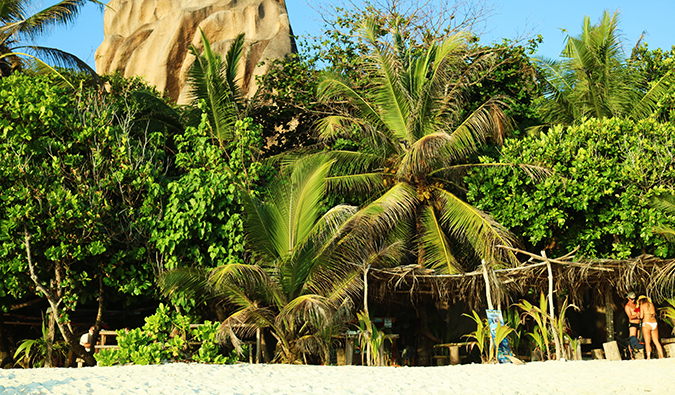
Unlike many beach paradises, you don’t need to go out on a boat to get to prime snorkeling territory. You can swim straight off the beach onto a reef and see rays, sharks, eels, fish, and more. I swam out from Anse Source d’Argent and was greeted by a friendly ray who let me follow him for half an hour in perfect peace. It was magical. However, renting a snorkel and mask often can get expensive. Snorkel rentals go for $10 USD a day or more. Bring your own to save money!
***
By following the above advice, it should be possible to take a trip to the Seychelles that doesn’t cost an arm and a leg (maybe just a hand). If you stay in small guesthouses that serve breakfast, eat takeout for most of your meals, spend most of your time exploring the beaches, and hunt for a good flight deal, you’ll spend between $120–140 USD per day (less if you are traveling with someone and can split accommodation costs), though it’s also good to leave some wiggle room for putting money in the hands of any Seychellois guides or vendors who really make a difference to your trip.
If you are willing to shell out more, then the sky’s the limit, but if splurging, I would recommend a guided tour through the jungle (it’s typically not safe to venture out alone) or diving, as the Seychelles are home to some world-famous dive sites. A whole day’s guided hike, including lunch and entrance to world-famous beach Anse Source d’Argent, costs about $70 USD, and each dive with Octopus Dive Centre was around $60 USD (less if you have your own equipment). I did both of these activities and they were completely worth it.
I firmly believe that the Seychelles is one of the world’s most beautiful places and should be on the bucket list of any avid traveler. And, hopefully, these budget tips will allow you to visit the Seychelles without breaking the bank!
Ellie Hopgood is an investment writer in London, covering topics in economics, politics and global finance. She writes about travel, politics and photography on her blog Endlessly Restless. She spends a borderline unhealthy amount of time editing photos and checking the cost of flights to places she has no immediate intention to visit. You can find her on Twitter (@elliemhopgood).
P.S. – Did you know I wrote a new book? It’s called “Ten Years a Nomad” and it’s all about the lessons I’ve learned from a life of travel. It features tons of stories and misadventures I’ve never told on this blog as well! Click here to learn more and grab your copy today! (I’m doing a book tour too! I’ll be in Austin, Houston, Denver, and San Diego next week!)
Book Your Trip to the Seychelles: Logistical Tips and Tricks
Book Your Flight
Find a cheap flight by using Skyscanner or Momondo. They are my two favorite search engines because they search websites and airlines around the globe so you always know no stone is left unturned.
Book Your Accommodation
You can book your hostel with Hostelworld. If you want to stay somewhere other than a hostel, use Booking.com as they consistently return the cheapest rates for guesthouses and cheap hotels. I use them all the time.
Don’t Forget Travel Insurance
Travel insurance will protect you against illness, injury, theft, and cancellations. It’s comprehensive protection in case anything goes wrong. I never go on a trip without it as I’ve had to use it many times in the past. I’ve been using World Nomads for ten years. My favorite companies that offer the best service and value are:
Looking for the best companies to save money with?
Check out my resource page for the best companies to use when you travel! I list all the ones I use to save money when I travel – and I think will help you too!
Looking for more information on visiting the Seychelles?
Check out my in-depth destination guide to the Seychelles with more tips on what to see, do, costs, ways to save, and much, much more!
The post How to Visit the Seychelles on a Budget appeared first on Nomadic Matt's Travel Site.
 Posted: 2/3/2020 | February 3rd, 2020
One of the countries high up on my “must visit” list is Egypt. As a lover of history, I long to release my inner archaeologist and explore the many ruins of the country. While it might be a long time before I get there, my friend Jeremy Scott Foster from TravelFreak has visited a couple of times. In this guest post, he’ll give you his best tips for saving money on your next visit to Egypt!
I’ve been to Egypt twice. On my first trip four years ago, I solo traveled the Sinai Peninsula along the Gulf of Aqaba, stayed in shared hostels for $5 USD per night and took overnight buses that cost just as little. On my most recent trip last year, I traveled from the very north of Egypt in Alexandria south to Cairo, and then further south along the Nile River to the border with Sudan.
And, throughout it all, I fall deeply in love with this country where foreign perception of violence keeps so many at arm’s length.
The tourism industry in Egypt is still feeling pain as a result of the political upheaval, civil unrest, and terrorism-related activities that have marred its recent history. As tourist numbers have dwindled and competition for the tourist dollar has become fiercer, travel deals have proliferated.
But what most visitors miss is what you can gain — free of crowds and for little money too.
From the chaos of Cairo to the more laid-back vibe of Luxor, Egypt is an ideal destination for budget travelers.
Posted: 2/3/2020 | February 3rd, 2020
One of the countries high up on my “must visit” list is Egypt. As a lover of history, I long to release my inner archaeologist and explore the many ruins of the country. While it might be a long time before I get there, my friend Jeremy Scott Foster from TravelFreak has visited a couple of times. In this guest post, he’ll give you his best tips for saving money on your next visit to Egypt!
I’ve been to Egypt twice. On my first trip four years ago, I solo traveled the Sinai Peninsula along the Gulf of Aqaba, stayed in shared hostels for $5 USD per night and took overnight buses that cost just as little. On my most recent trip last year, I traveled from the very north of Egypt in Alexandria south to Cairo, and then further south along the Nile River to the border with Sudan.
And, throughout it all, I fall deeply in love with this country where foreign perception of violence keeps so many at arm’s length.
The tourism industry in Egypt is still feeling pain as a result of the political upheaval, civil unrest, and terrorism-related activities that have marred its recent history. As tourist numbers have dwindled and competition for the tourist dollar has become fiercer, travel deals have proliferated.
But what most visitors miss is what you can gain — free of crowds and for little money too.
From the chaos of Cairo to the more laid-back vibe of Luxor, Egypt is an ideal destination for budget travelers.
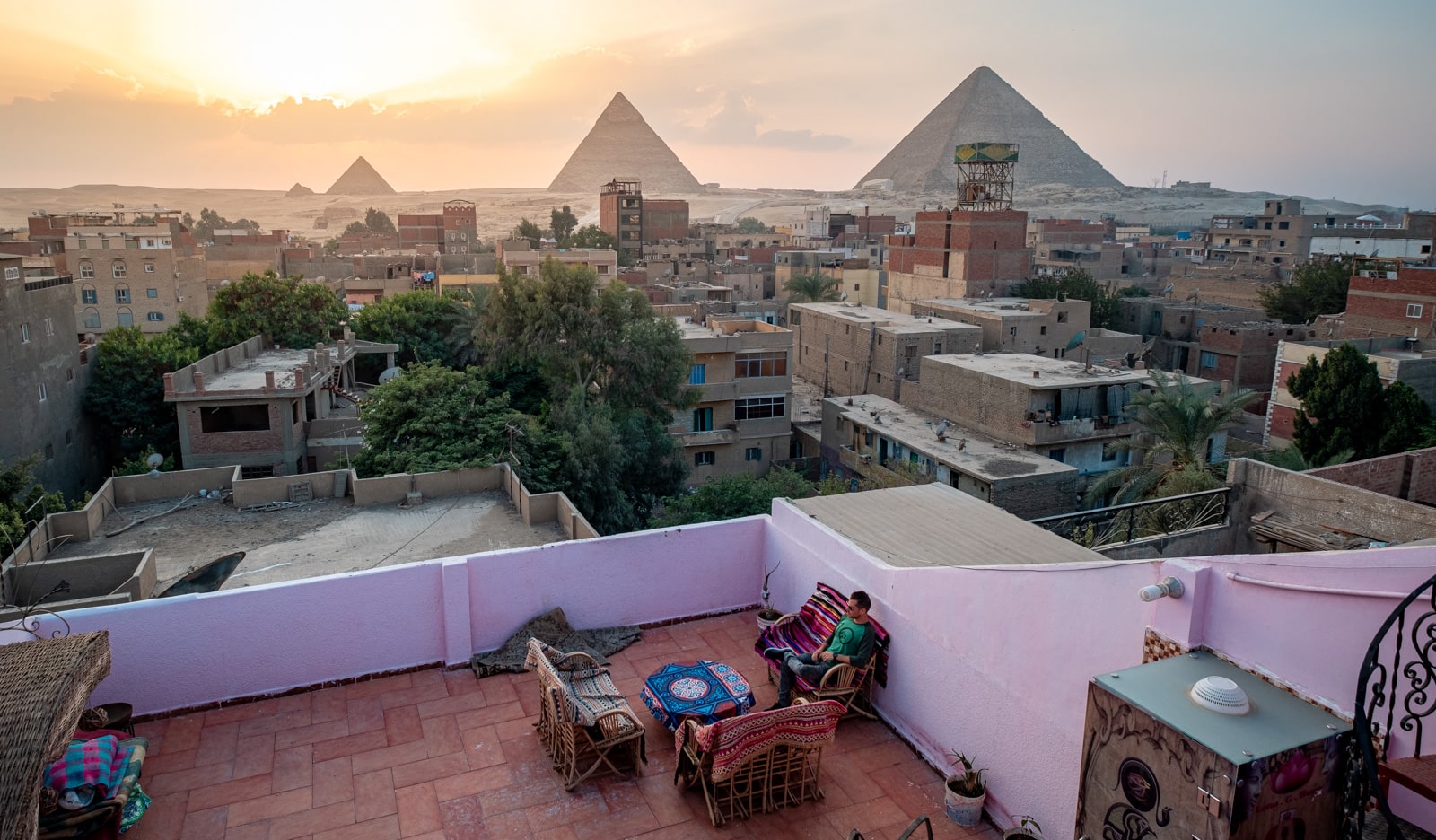 Generally speaking, accommodation in Egypt is relatively affordable. However, there are a few helpful tricks that can cut down your expenses.
Stay in hostels instead of hotels – Typically, you can expect to find a bed in a shared dorm room (with 4+ beds) for between $5-8 USD per night, or a comfortable private single room for about $15 USD per night. You will likely have to share a bathroom, but at least you have your privacy.
Use Hostelworld to look for the best prices. I recommend Dahab Hostel in Cairo and Al Salam Camp in Luxor.
Use Booking.com to compare prices for hotels – If you’re looking for cheap hotels or guesthouses in Egypt, I recommend checking Booking.com. A private room in a guesthouse or hotel goes for about $40 USD per night.
Prices are generally listed per room, not per person. So, if you are traveling with a friend, you can save even more money by splitting the cost.
Look for accommodations that add offer a little extra – I also found that, coupled with accommodation, it was pretty common for hosts in guesthouses to offer extras such as breakfast and local tours at very reasonable prices. One of my incredible hosts cooked a traditional hot breakfast with tea and coffee for just $1 USD. Best of all, he was more than happy to recommend some inexpensive local places to eat and buy food.
Look beyond the standard hotel rooms for accommodation options – Vrbo and HomeAway are great Airbnb alternatives, as they’ve been connecting budget travelers and homeowners since the ’90s. HomeAway is geared towards people wanting a proper vacation rental, so you can expect a fully furnished home to live in which is great for longer stays.
Vrbo lets you stay in a local’s house, but at a slightly increased cost. You can usually find some pretty luxurious apartments starting from $50 USD per night.
The upside is that you’ll have full access to your own kitchen, which means you can further cut your costs by cooking at home.
Generally speaking, accommodation in Egypt is relatively affordable. However, there are a few helpful tricks that can cut down your expenses.
Stay in hostels instead of hotels – Typically, you can expect to find a bed in a shared dorm room (with 4+ beds) for between $5-8 USD per night, or a comfortable private single room for about $15 USD per night. You will likely have to share a bathroom, but at least you have your privacy.
Use Hostelworld to look for the best prices. I recommend Dahab Hostel in Cairo and Al Salam Camp in Luxor.
Use Booking.com to compare prices for hotels – If you’re looking for cheap hotels or guesthouses in Egypt, I recommend checking Booking.com. A private room in a guesthouse or hotel goes for about $40 USD per night.
Prices are generally listed per room, not per person. So, if you are traveling with a friend, you can save even more money by splitting the cost.
Look for accommodations that add offer a little extra – I also found that, coupled with accommodation, it was pretty common for hosts in guesthouses to offer extras such as breakfast and local tours at very reasonable prices. One of my incredible hosts cooked a traditional hot breakfast with tea and coffee for just $1 USD. Best of all, he was more than happy to recommend some inexpensive local places to eat and buy food.
Look beyond the standard hotel rooms for accommodation options – Vrbo and HomeAway are great Airbnb alternatives, as they’ve been connecting budget travelers and homeowners since the ’90s. HomeAway is geared towards people wanting a proper vacation rental, so you can expect a fully furnished home to live in which is great for longer stays.
Vrbo lets you stay in a local’s house, but at a slightly increased cost. You can usually find some pretty luxurious apartments starting from $50 USD per night.
The upside is that you’ll have full access to your own kitchen, which means you can further cut your costs by cooking at home.
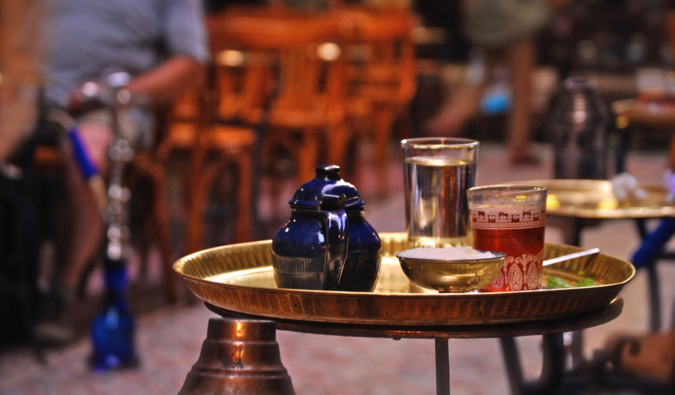 Stick to the local eats and street food – If you want to save money on food while traveling in Egypt, do yourself a favor and steer clear of the Western chain food joints. While a cheeseburger is about half the price of what you pay at home, it’s still more expensive, less tasty, and far less adventurous than experiencing the local cuisine.
Why bother with a burger when you can eat the most delicious falafel in the world for $1 USD?
Navigate the narrow alleyways of any bustling Cairo market (like Khan El Khalili or Mohammed Ali Street) to seek out the best shawarma ($2 USD). Or grab a stuffed falafel sandwich from a street vendor on your way from one ancient relic to another ($2 USD). You can literally find Arabic bread for 5 cents. It’s all cheap and very filling.
And, the hummus. It’s so. Darn. Good.
If you’re staying at a guesthouse, it’s common practice for them to offer full dinners for about $10 USD. The truth is that they’re actually just sourcing the food from restaurants in the neighborhood and taking a cut, so by seeking out your own food options, expect to spend about ¼ of the price.
With that said, don’t be afraid of street food or street vendors, especially if the food is cooked in front of you. And if there is a crowd of locals waiting, then chances are you’re onto a good thing.
Eat at a kosheri – A kosheri is a small, local restaurant that serves up generous portions of pasta, chickpeas, lentils, etc. often for less than $1 USD! There’s no menu, you just select the size of your portion and then you’re served this mishmash of deliciousness.
Cook your own meals – As mentioned, preparing your own meals while traveling is also a great money saver. If you have access to a kitchen, just ask your host to point you in the direction of the nearest market. They also have the lowdown on where to eat for cheap, so take advantage of their local knowledge!
Stick to the local eats and street food – If you want to save money on food while traveling in Egypt, do yourself a favor and steer clear of the Western chain food joints. While a cheeseburger is about half the price of what you pay at home, it’s still more expensive, less tasty, and far less adventurous than experiencing the local cuisine.
Why bother with a burger when you can eat the most delicious falafel in the world for $1 USD?
Navigate the narrow alleyways of any bustling Cairo market (like Khan El Khalili or Mohammed Ali Street) to seek out the best shawarma ($2 USD). Or grab a stuffed falafel sandwich from a street vendor on your way from one ancient relic to another ($2 USD). You can literally find Arabic bread for 5 cents. It’s all cheap and very filling.
And, the hummus. It’s so. Darn. Good.
If you’re staying at a guesthouse, it’s common practice for them to offer full dinners for about $10 USD. The truth is that they’re actually just sourcing the food from restaurants in the neighborhood and taking a cut, so by seeking out your own food options, expect to spend about ¼ of the price.
With that said, don’t be afraid of street food or street vendors, especially if the food is cooked in front of you. And if there is a crowd of locals waiting, then chances are you’re onto a good thing.
Eat at a kosheri – A kosheri is a small, local restaurant that serves up generous portions of pasta, chickpeas, lentils, etc. often for less than $1 USD! There’s no menu, you just select the size of your portion and then you’re served this mishmash of deliciousness.
Cook your own meals – As mentioned, preparing your own meals while traveling is also a great money saver. If you have access to a kitchen, just ask your host to point you in the direction of the nearest market. They also have the lowdown on where to eat for cheap, so take advantage of their local knowledge!
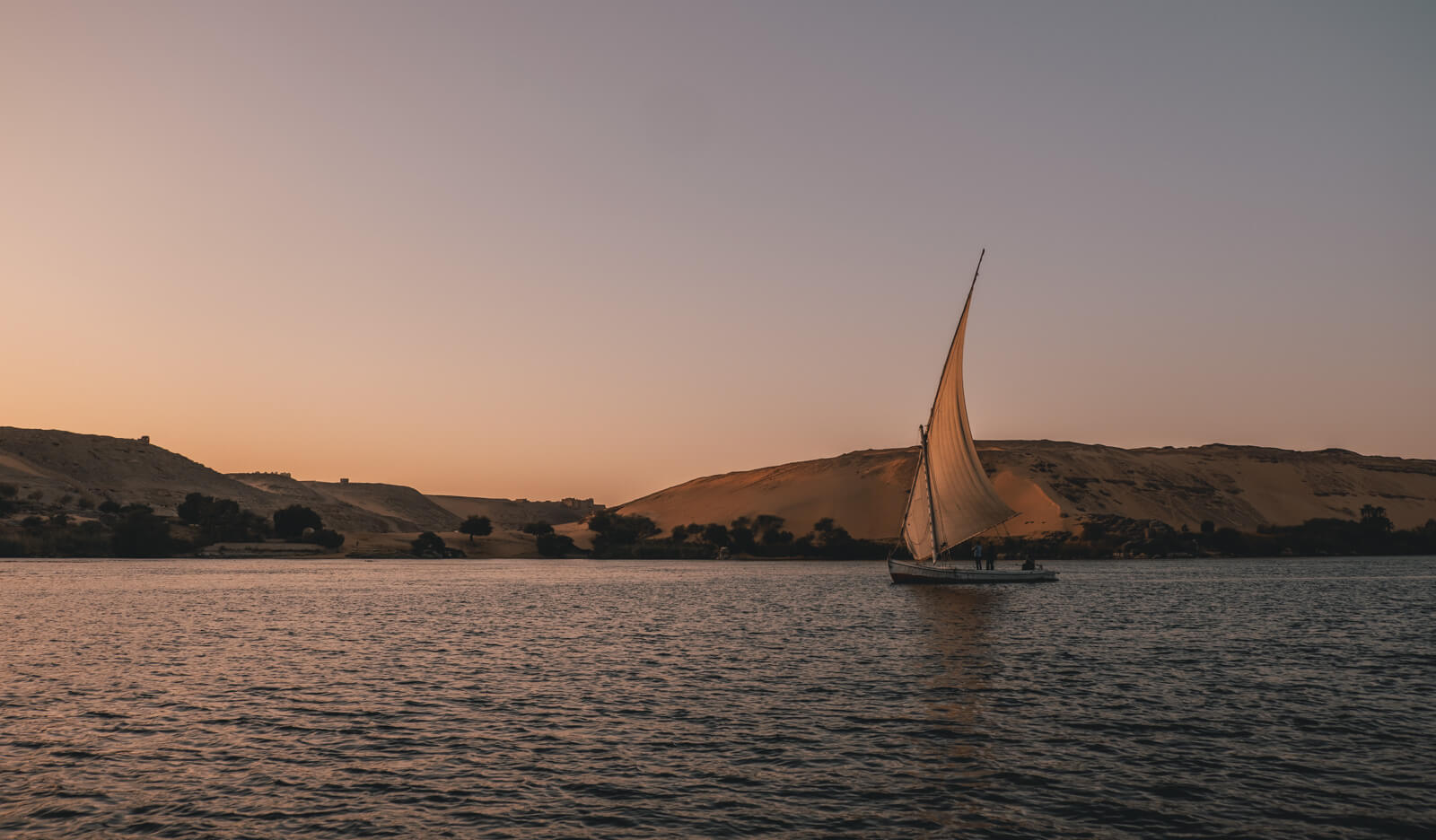 Bargain with your taxi driver – In most Egyptian cities, taxis are an inexpensive and convenient way to get around.
Now, when I say convenient, I mean they’ll get you to where you need to go relatively quickly. But I would be remiss if I didn’t add a few disclaimers.
Taxi drivers can be aggressive on the road, leaving you white-knuckled from hanging on for dear life. I’ve never experienced a more heart-stopping journey than a Cairo taxi ride.
Furthermore, while Cairo does have metered taxis, don’t be lulled into a false sense of security. Meters are notoriously unreliable or rigged, and drivers frequently “forget” to turn them on. It’s one of the oldest travel scams in the book.
The best practice is to use an unmetered taxi and agree on a price with the driver before getting in. (Outside Cairo, most taxis are unmetered, so no matter what, always agree on a price upfront.)
If you’re not sure how much is an acceptable price, ask someone at your hostel or guesthouse for a pricing recommendation, and then start your bargaining at about ½ that price. Oftentimes even they will give you a higher estimate than is normal (it’s locals helping locals), but the real price should be about ¾ of what you’ve been recommended.
For longer-distance trips, hiring a car with a driver is the most cost-effective option. The price will be the same whether you’re traveling by yourself or with a group of four, so round up some travel buddies and split the cost.
But of course, be prepared for some aggressive haggling to get the best price. Be clear about where you want to go and for how long you will need the driver. Don’t worry if negotiations break down, though. When it comes to haggling over price, never be afraid to walk away. There are plenty of drivers available, so just move on to the next one.
Take the local train – Taking the train between Alexandria, Cairo, Luxor, and Aswan is the most popular mode of transport for this route.
If time or budget is a concern, you can take an overnight train. By taking the sleeper train from Cairo to Luxor or Aswan, you’ll save a night’s worth of accommodation in a hotel. A deluxe sleeper cabin for one is about $110 USD, while a two-berth cabin is $80 USD per person. Cabins are secure, and fares include an airline-style dinner and breakfast. The food is basic, but it’s edible.
But for a real bargain, you can book the day train between Cairo and Luxor or Aswan for as little as $10 USD. However, there’s one caveat: for safety reasons, the Egyptian government prohibits foreigners from purchasing day train tickets for this route. Officials say this is because only the night trains have armed guards in case of a terrorist attack, but this is an incredibly rare occurrence.
It’s easy to get around this, though. You’ll need to book tickets online at enr.gov.eg (you’ll have to register an account but it’s easy to do) or ask your guide, host, or driver to book the tickets for you. They will likely oblige for a small fee.
There are no reports of ticket attendants kicking any foreigners off the day train, so you’ll be fine. And if not, you’re only out $10 USD.
Get the Flight Pass – The fastest way to travel around Egypt is by plane. Egypt Air is the national carrier and Star Alliance Member serving most major domestic destinations. Its Flight Pass is a cost-effective option that allows you to lock in low fares for domestic flights even if you haven’t determined your travel dates.
All you have to do is purchase a minimum of four flights (or credits) and choose a time when you’d like to travel in the next 12 months. You can then book your flight up to seven days before departure.
On the downside, you’ll have to always fly back to your original departure point. That is, instead of flying from Cairo to Luxor and Alexandria, you’ll need to fly Cairo to Luxor and back to Cairo before going to Alexandria. That said, the Flight Pass is still about 30% cheaper than booking the same multi-destination flights with other airlines.
The Flight Pass is super customizable. You can select the number of flights (e.g. four, which is two round-trip flights) for a period of time (e.g. within one month), and also how early you can book your flights (e.g. one week before travel). This means that if you pick Cairo as your origin, you can select two round-trip flights to Aswan, Luxor, Alexandria, Sharm E Sheikh, or Hurghada. Each flight is $73 USD one-way.
But if I were to book a flight from Cairo to Luxor for one week from now, that same leg would cost at least $142 USD!
You can play around with this pass. For example, if you purchase a similar pass to the one above but select “one month” for how early you can book, the flights become $66 USD each per one-way.
If that’s too much of an inconvenience for you, there are plenty of other airlines offering affordable flights. When it comes to finding cheap flights on other airlines, I use Skyscanner. By being flexible with your dates, you can save up to 50%. Keep in mind, though, that you might be traveling at inconvenient times, like the middle of the night.
In the Skyscanner search bar, instead of entering specific dates, select the “Entire Month” option. This will show you a calendar with fare prices for departing and returning flights for every day of the month. This also works for one-way flights. However, it does not work for multicity flights.
Bargain with your taxi driver – In most Egyptian cities, taxis are an inexpensive and convenient way to get around.
Now, when I say convenient, I mean they’ll get you to where you need to go relatively quickly. But I would be remiss if I didn’t add a few disclaimers.
Taxi drivers can be aggressive on the road, leaving you white-knuckled from hanging on for dear life. I’ve never experienced a more heart-stopping journey than a Cairo taxi ride.
Furthermore, while Cairo does have metered taxis, don’t be lulled into a false sense of security. Meters are notoriously unreliable or rigged, and drivers frequently “forget” to turn them on. It’s one of the oldest travel scams in the book.
The best practice is to use an unmetered taxi and agree on a price with the driver before getting in. (Outside Cairo, most taxis are unmetered, so no matter what, always agree on a price upfront.)
If you’re not sure how much is an acceptable price, ask someone at your hostel or guesthouse for a pricing recommendation, and then start your bargaining at about ½ that price. Oftentimes even they will give you a higher estimate than is normal (it’s locals helping locals), but the real price should be about ¾ of what you’ve been recommended.
For longer-distance trips, hiring a car with a driver is the most cost-effective option. The price will be the same whether you’re traveling by yourself or with a group of four, so round up some travel buddies and split the cost.
But of course, be prepared for some aggressive haggling to get the best price. Be clear about where you want to go and for how long you will need the driver. Don’t worry if negotiations break down, though. When it comes to haggling over price, never be afraid to walk away. There are plenty of drivers available, so just move on to the next one.
Take the local train – Taking the train between Alexandria, Cairo, Luxor, and Aswan is the most popular mode of transport for this route.
If time or budget is a concern, you can take an overnight train. By taking the sleeper train from Cairo to Luxor or Aswan, you’ll save a night’s worth of accommodation in a hotel. A deluxe sleeper cabin for one is about $110 USD, while a two-berth cabin is $80 USD per person. Cabins are secure, and fares include an airline-style dinner and breakfast. The food is basic, but it’s edible.
But for a real bargain, you can book the day train between Cairo and Luxor or Aswan for as little as $10 USD. However, there’s one caveat: for safety reasons, the Egyptian government prohibits foreigners from purchasing day train tickets for this route. Officials say this is because only the night trains have armed guards in case of a terrorist attack, but this is an incredibly rare occurrence.
It’s easy to get around this, though. You’ll need to book tickets online at enr.gov.eg (you’ll have to register an account but it’s easy to do) or ask your guide, host, or driver to book the tickets for you. They will likely oblige for a small fee.
There are no reports of ticket attendants kicking any foreigners off the day train, so you’ll be fine. And if not, you’re only out $10 USD.
Get the Flight Pass – The fastest way to travel around Egypt is by plane. Egypt Air is the national carrier and Star Alliance Member serving most major domestic destinations. Its Flight Pass is a cost-effective option that allows you to lock in low fares for domestic flights even if you haven’t determined your travel dates.
All you have to do is purchase a minimum of four flights (or credits) and choose a time when you’d like to travel in the next 12 months. You can then book your flight up to seven days before departure.
On the downside, you’ll have to always fly back to your original departure point. That is, instead of flying from Cairo to Luxor and Alexandria, you’ll need to fly Cairo to Luxor and back to Cairo before going to Alexandria. That said, the Flight Pass is still about 30% cheaper than booking the same multi-destination flights with other airlines.
The Flight Pass is super customizable. You can select the number of flights (e.g. four, which is two round-trip flights) for a period of time (e.g. within one month), and also how early you can book your flights (e.g. one week before travel). This means that if you pick Cairo as your origin, you can select two round-trip flights to Aswan, Luxor, Alexandria, Sharm E Sheikh, or Hurghada. Each flight is $73 USD one-way.
But if I were to book a flight from Cairo to Luxor for one week from now, that same leg would cost at least $142 USD!
You can play around with this pass. For example, if you purchase a similar pass to the one above but select “one month” for how early you can book, the flights become $66 USD each per one-way.
If that’s too much of an inconvenience for you, there are plenty of other airlines offering affordable flights. When it comes to finding cheap flights on other airlines, I use Skyscanner. By being flexible with your dates, you can save up to 50%. Keep in mind, though, that you might be traveling at inconvenient times, like the middle of the night.
In the Skyscanner search bar, instead of entering specific dates, select the “Entire Month” option. This will show you a calendar with fare prices for departing and returning flights for every day of the month. This also works for one-way flights. However, it does not work for multicity flights.
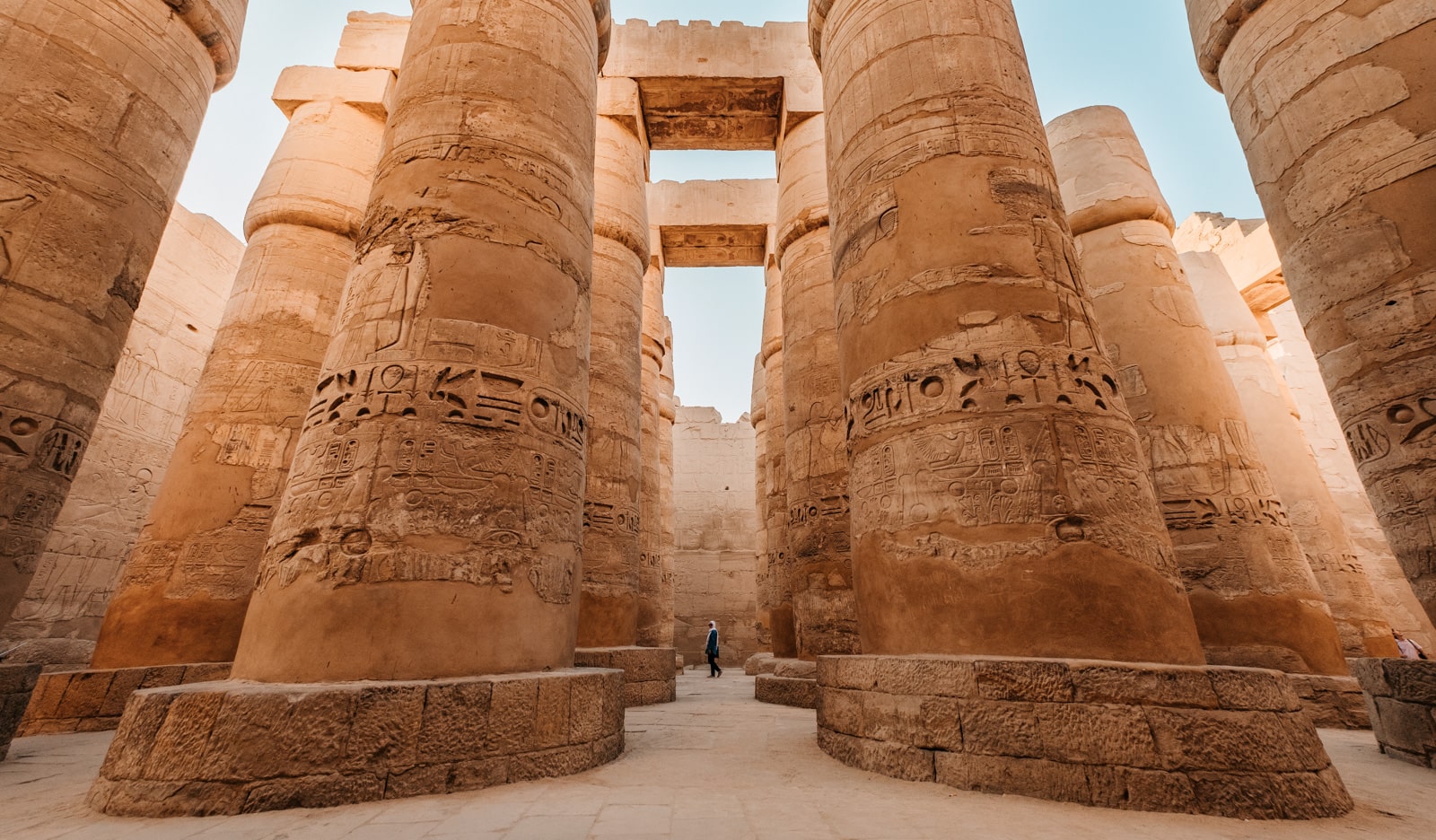 The best money-saving tip I can offer here is to avoid booking online before you arrive in Egypt.
If you’re a Type A traveler who needs a plan in hand before you even arrive, you’re not going to like this. But online agencies charge massively inflated prices, and you will end up paying a lot less if you deal directly with the tour company or guide locally on the ground.
Add in the feel-good factor of your money going directly to your guide, their family, and community (and not to some middle person, agency, or large corporation) and you’ve got yourself a win-win situation.
You may need to be a little more flexible with your dates. But you will have the added advantage of being able to negotiate (haggle, in reality), which translates to overall savings.
Tours, private drivers, and the quintessential cruise down the Nile can all be booked locally at significantly lower prices than booking in advance. So, if you can stomach it, wait until you get your boots on the ground before booking your tours.
Guides, in my experience, are an invaluable source of local knowledge and information. They have the inside scoop on the best vantage points for photos at all the epic landmarks. In addition, they’re great at dealing with those persistent and sometimes aggressive street vendors.
The best guides can be found by asking for recommendations from other travelers who have used their services, but I always recommend my Egyptian brother, Rami.
Back in 2015, on my first trip to Egypt, Rami and I connected by way of a mutual friend. We hit it off, and ever since then, I’ve helped him to grow the little tour business he and his family-run. It feels good to be able to help a local family in such a positive way.
He’s honest, affordable, reliable, incredibly communicative, well connected, and did I mention honest? That’s one of the difficult parts about traveling in places like Egypt: when people are selling you things, it’s hard to know who you can trust.
But Rami is my man. Send him an email at ramielshaer2@gmail.com and let him know Jeremy sent you (there are no commissions here — this is just a helpful referral to a well-deserving friend). He will sort you out or put you in touch with someone else in your preferred destination.
The best money-saving tip I can offer here is to avoid booking online before you arrive in Egypt.
If you’re a Type A traveler who needs a plan in hand before you even arrive, you’re not going to like this. But online agencies charge massively inflated prices, and you will end up paying a lot less if you deal directly with the tour company or guide locally on the ground.
Add in the feel-good factor of your money going directly to your guide, their family, and community (and not to some middle person, agency, or large corporation) and you’ve got yourself a win-win situation.
You may need to be a little more flexible with your dates. But you will have the added advantage of being able to negotiate (haggle, in reality), which translates to overall savings.
Tours, private drivers, and the quintessential cruise down the Nile can all be booked locally at significantly lower prices than booking in advance. So, if you can stomach it, wait until you get your boots on the ground before booking your tours.
Guides, in my experience, are an invaluable source of local knowledge and information. They have the inside scoop on the best vantage points for photos at all the epic landmarks. In addition, they’re great at dealing with those persistent and sometimes aggressive street vendors.
The best guides can be found by asking for recommendations from other travelers who have used their services, but I always recommend my Egyptian brother, Rami.
Back in 2015, on my first trip to Egypt, Rami and I connected by way of a mutual friend. We hit it off, and ever since then, I’ve helped him to grow the little tour business he and his family-run. It feels good to be able to help a local family in such a positive way.
He’s honest, affordable, reliable, incredibly communicative, well connected, and did I mention honest? That’s one of the difficult parts about traveling in places like Egypt: when people are selling you things, it’s hard to know who you can trust.
But Rami is my man. Send him an email at ramielshaer2@gmail.com and let him know Jeremy sent you (there are no commissions here — this is just a helpful referral to a well-deserving friend). He will sort you out or put you in touch with someone else in your preferred destination.
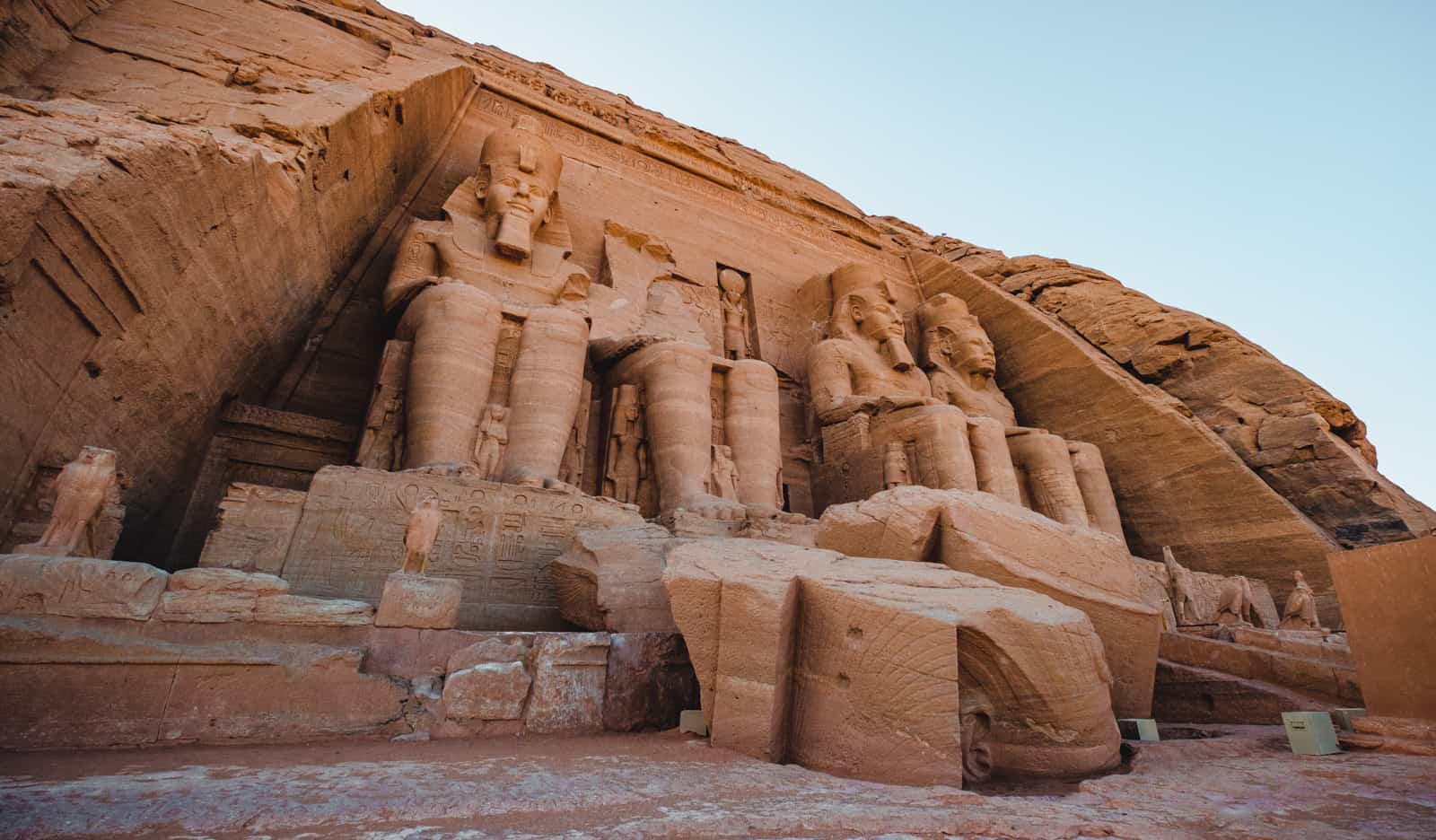 Get the International Student Identity Card – Entrance and admission prices for almost all monuments and attractions in Egypt are set as advertised. However, you can get discounted tickets with an International Student Identity Card, including 50% off some of Egypt’s best museums (including the Luxor).
Get a travel pass – You can get a Cairo Pass or a Luxor Pass (multi-entrance discount passes) from the Ministry of Antiquities, the Egyptian Museum, or the Giza Plateau for about $80 USD. You’ll save about 50% off entries to over 30 attractions in Cairo and Giza. You’ll find very little information about these passes online, however, so your best bet is to just show up at one of those locations and inquire there.
Get the International Student Identity Card – Entrance and admission prices for almost all monuments and attractions in Egypt are set as advertised. However, you can get discounted tickets with an International Student Identity Card, including 50% off some of Egypt’s best museums (including the Luxor).
Get a travel pass – You can get a Cairo Pass or a Luxor Pass (multi-entrance discount passes) from the Ministry of Antiquities, the Egyptian Museum, or the Giza Plateau for about $80 USD. You’ll save about 50% off entries to over 30 attractions in Cairo and Giza. You’ll find very little information about these passes online, however, so your best bet is to just show up at one of those locations and inquire there.
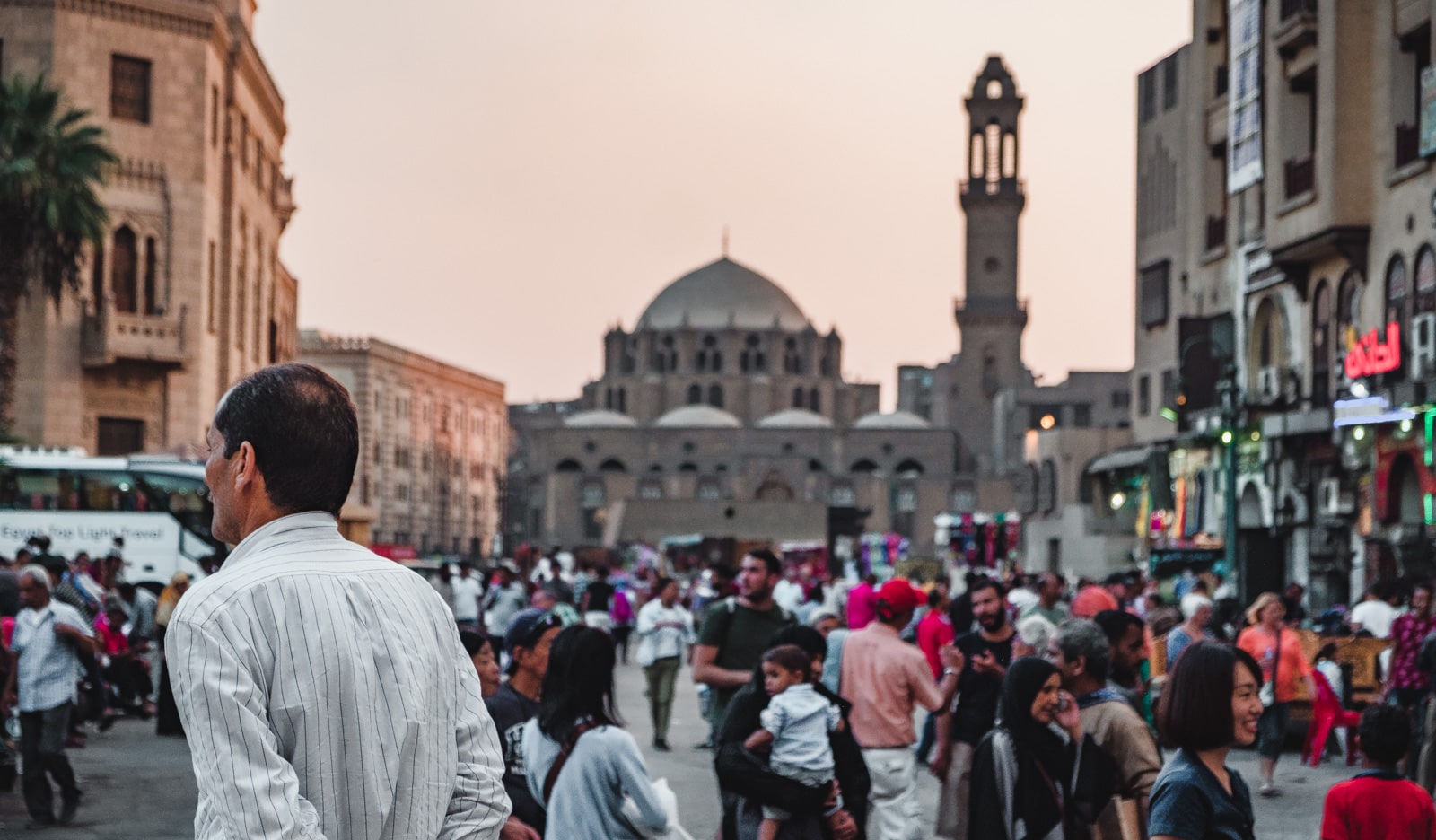 While you can spend money on luxury resorts or private tours, it’s entirely possible to travel through Egypt on the cheap. In fact, you can easily spend as little as $30-$35 USD a day.
The biggest way to reduce costs is to stay in dorm rooms or hostels. If you opt for a private room or mid-range hotel, you can expect to spend $30-40 USD more per night.
Where and what you eat also adds to your daily budget. For example, street food is an affordable and filling option for dining in Egypt. You can eat everything from falafel and sandwiches to shawarma and koshari noodles for as little as $1 USD.
Eating in a restaurant is more expensive, but still relatively cheap compared to Western countries. Meals in a mid-range restaurant start at $4 USD, while international dishes can be around $10 USD.
Transportation is another added cost. Train travel can be cheap but may not be the most efficient option if your time is limited. So, if you plan to fly between your destinations, expect to add $50-$100 USD to your budget for each flight.
Of course, your daily budget will also increase if you book private guides or splurge on souvenirs and gifts.
And remember, haggling is one of the most important skills if you’re looking to save money in Egypt. Taxis, excursions, and other services can usually be bargained down to a lower rate than what is initially quoted. So, if you have a high tolerance for haggling, your daily budget could easily be less.
Regardless, it’s always better to go slightly over budget, especially somewhere with as many must-see sights and experiences as Egypt!
While you can spend money on luxury resorts or private tours, it’s entirely possible to travel through Egypt on the cheap. In fact, you can easily spend as little as $30-$35 USD a day.
The biggest way to reduce costs is to stay in dorm rooms or hostels. If you opt for a private room or mid-range hotel, you can expect to spend $30-40 USD more per night.
Where and what you eat also adds to your daily budget. For example, street food is an affordable and filling option for dining in Egypt. You can eat everything from falafel and sandwiches to shawarma and koshari noodles for as little as $1 USD.
Eating in a restaurant is more expensive, but still relatively cheap compared to Western countries. Meals in a mid-range restaurant start at $4 USD, while international dishes can be around $10 USD.
Transportation is another added cost. Train travel can be cheap but may not be the most efficient option if your time is limited. So, if you plan to fly between your destinations, expect to add $50-$100 USD to your budget for each flight.
Of course, your daily budget will also increase if you book private guides or splurge on souvenirs and gifts.
And remember, haggling is one of the most important skills if you’re looking to save money in Egypt. Taxis, excursions, and other services can usually be bargained down to a lower rate than what is initially quoted. So, if you have a high tolerance for haggling, your daily budget could easily be less.
Regardless, it’s always better to go slightly over budget, especially somewhere with as many must-see sights and experiences as Egypt!





